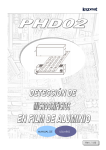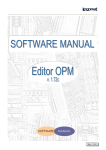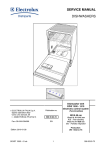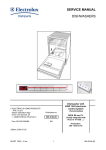Download USER'S MANUAL
Transcript
USER’S MANUAL Rev. 1.00 USER’S MANUAL PHD02 LOGOMAT s.r.l. 40067 Pianoro (BO) Italia Via V. Bellini, 6 (Loc. Rastignano) Tel. (051) 626.00.70 Telefax (051) 626.01.11 E-mail: [email protected] http://www.logomat.it 2 Rev. 1.00 This document is the property of LOGOMAT s.r.l. Total or partial reproduction of this document is prohibited without the express authorization of LOGOMAT s.r.l.. USER’S MANUAL PHD02 Contents 1. Introduction ......................................................................................................................... 4 1.1. Function of the device.................................................................................................................................. 4 2. Composition of the device ................................................................................................ 4 2.1. 2.2. 2.3. Infrared illuminator........................................................................................................................................ 5 Light receiver................................................................................................................................................. 6 Gauge............................................................................................................................................................ 6 3. Technical specifications .................................................................................................... 7 3.1. 3.2. Technical specifications - Electrical ........................................................................................................... 7 Technical specifications - Mechanical....................................................................................................... 7 4. Device operation................................................................................................................ 9 4.1. 4.2. Device operation- Illuminator...................................................................................................................... 9 Device operation- Receiver ...................................................................................................................... 10 5. Installing and mounting the device................................................................................ 11 5.1. 5.2. Terminal board electrical connections ILLUMINATOR ............................................................................. 12 Terminal board electrical connections RECEIVER.................................................................................... 12 6. Checking operation and calibration with calibrated micro-holes ............................. 13 6.1. Detection parameters with calibrated micro-holes ................................................................................ 13 3 Rev. 1.00 This document is the property of LOGOMAT s.r.l. Total or partial reproduction of this document is prohibited without the express authorization of LOGOMAT s.r.l.. USER’S MANUAL PHD02 1. Introduction 1.1. Function of the device This device is used on blister-forming machines that use aluminium film to form the blisters. Its function is that of checking the integrity of the aluminium film by detecting the presence of micro-holes, tears or splits already present in the film or produced during the work process (deep-drawing). The detection of a film defect (if any)(i.e. missing opacity) causes the activation of an electric signal (relay contact) that can be used to cause the reject of the involved area. The dimensions of the hole causing the device to intervene (intervention threshold) can be set by means of a “multiturn knob” (trimmer) which is located on the receiver and that can be verified by means of suitable calibrated micro-holes. 2. Composition of the device The device consists of two completely separate parts: • illuminator (Fig. 1 – Ref. 1) • receiver (Fig. 1 – Ref. 2) Fig. 1 4 Rev. 1.00 This document is the property of LOGOMAT s.r.l. Total or partial reproduction of this document is prohibited without the express authorization of LOGOMAT s.r.l.. USER’S MANUAL PHD02 Both the illuminator and the receiver are identified by means of a code which is defined as follows: Fig. 2 N.B.: for spare parts, service or replacement of the device, always indicate the code mentioned above. 2.1. Infrared illuminator This component, usually fitted on the film sliding surface, consists of the following parts: • Photodiode linear arrays with infrared emission on the whole width of the film to inspect (Fig. 3 – Ref. 1) • Focalisation optical lens (Fig. 3 – Ref. 2) • 2 luminous LEDs [one GREEN (Fig. 3 – Ref. 3) and one RED (Fig. 3 – Ref. 4)], positioned on the side wall of the illuminator, that identify the operating condition (NORMAL or FAULTY) • PWM circuit for piloting the diodes (Fig. 3 – Ref. 5) • Alarm circuit for short-circuited diode or for diode opened on the array (Fig. 3 – Ref. 6) • Power supply terminal board (Fig. 3 – Ref. 7) • Alarm output optoisolator to the PLC in the event of LIGHT circuit faults Furthermore, two side supporting blocks are foreseen that keep the illuminator at an optimal height (15 mm) from the film in order to get maximum light on the reading spot. The illuminator has an independent power supply. Fig. 3 5 Rev. 1.00 This document is the property of LOGOMAT s.r.l. Total or partial reproduction of this document is prohibited without the express authorization of LOGOMAT s.r.l.. USER’S MANUAL PHD02 2.2. Light receiver The receiver is usually fitted below the film sliding surface and consists of the following parts: • Receiving photodiode arrays for infrared, positioned along the reading axis and as long as the width of the film to check • 2 luminous LEDs [one GREEN and one RED ], positioned on the side wall of the receiver to identify the operating condition (normal or micro-hole present) • Instrumentation amplifier circuit • Comparator circuit to detect micro-holes • Alarm output optoisolator to the PLC • 10-turn potentiometer to adjust the intervention threshold In the event of drawn films, the format manufacturer should foresee a support-guide, which is as much adherent as possible to the film lower part. 2.3. Gauge On request a kit can be supplied which consists of three gauges with calibrated holes of: 1. 0.035 mm 2. 0.050 mm 3. 0.100 mm both in the STANDARD version (+/- 10%) and in the version with metrological CERTIFICATE (+/- 2%). They can be useful to periodically check the calibration of the receiver (intervention threshold – see Chpt. 6). 6 Rev. 1.00 This document is the property of LOGOMAT s.r.l. Total or partial reproduction of this document is prohibited without the express authorization of LOGOMAT s.r.l.. USER’S MANUAL PHD02 3. Technical specifications 3.1. Technical specifications - Electrical ILLUMINATOR Power supply voltage 24 Vac or dc (to specify) Absorbed current 250 mA (short), 300 mA (medium), 350 mA (long) Fuse 1A (short), 1,5A (medium), 2A (long) Relay contact range 10 VA max. (Vmax = 100V, Imax. =400 mA) RECEIVER Power supply voltage 24 Vac or dc Absorbed current 50 mA max. (fuse 200mA) Min. detectable diameter 0,035 mm RELAY (10 VA max. -. 100V, 400 mA) Output STATIC with optoisolator (24 V – 20 mA max.) 3.2. Technical specifications - Mechanical ILLUMINATOR SHORT MEDIUM LONG SLOT length (LEf) 258 mm 286 mm 358 mm TOTAL length (LEt) 324 mm 360 mm 425 mm FASTENING centre distance (LEs) 314 mm 350 mm 415 mm FASTENING centre distance (LEst) 354 mm 390 mm 455mm WIDTH (PE) 50 mm 50 mm 50 mm HEIGHT (HE) 70 mm 70 mm 70 mm WEIGHT 1,4 kg 1,5 kg 1,7 kg 7 Rev. 1.00 This document is the property of LOGOMAT s.r.l. Total or partial reproduction of this document is prohibited without the express authorization of LOGOMAT s.r.l.. USER’S MANUAL PHD02 RECEIVER SHORT MEDIUM LONG SLOT length (LRf) 258 mm 286 mm 358 mm TOTAL length (LRt) 324 mm 360 mm 430 mm FASTENING centre distance (LRs) 314 mm 350 mm 420 mm WIDTH (PR) 50 mm 50 mm 50 mm HEIGHT (HR) 50 mm 50 mm 50 mm 230 mm 260 mm 330 mm 1,4 kg 1,5 kg 1,7 kg FILM width (optional band) WEIGHT Fig. 4 8 Rev. 1.00 This document is the property of LOGOMAT s.r.l. Total or partial reproduction of this document is prohibited without the express authorization of LOGOMAT s.r.l.. USER’S MANUAL PHD02 4. Device operation The device operation is described with individual references to the illuminator and the receiver. 4.1. Device operation- Illuminator The film to check (Fig. 5 – Ref. 1) slides, supported by the machine surface and shielded by the guides, between illuminator and receiver. The pulsating infrared light beam, emitted by the LED array of the illuminator (Fig. 5 – Ref. 2) (which covers the whole film width), is conveyed, by means of a Plexiglas linear lens (Fig. 5 – Ref. 3), onto the surface of the aluminium film that must be checked. When the GREEN LED (LdV) is ON, it signals that the device is supplied with power and the oscillator inside it operates correctly; if, on the contrary, the RED LED (LdR), which is connected to an automatic check circuit, lights ON, it signals the presence of an operating fault. When the red LED lights ON the internal relay for “light alarm” intervenes. Its contacts reach the terminal board. If the red LED lights ON, you need to immediately check the device operation (especially the power supply voltage) with micro-holes with calibrated diameter, by performing different tests in a transversal direction to the film advancement and consult the supplier for intervention, if necessary. When the illuminator operates correctly, i.e. LdV is ON and LdR is OFF, the alarm relay is energized and a line of infrared light is generated on the whole width of the film to check. Fig. 5 9 Rev. 1.00 This document is the property of LOGOMAT s.r.l. Total or partial reproduction of this document is prohibited without the express authorization of LOGOMAT s.r.l.. USER’S MANUAL PHD02 4.2. Device operation- Receiver For a correct operation, the receiver should be fitted under the film (as close as possible to it) in correspondence with the illuminator, aligning them as good as possible (Fig. 6). Fig. 6 When a micro-hole, if any (Fig. 6 – Ref. 1) is on the reading axis (above the receiver sensitive line) a fraction of the light emitted by the illuminator reaches an area of the line. The involved photosensors (Fig. 6 - Ref. 2) generate a signal whose intensity is proportional to the quantity of received light; if the amplitude of the light signal exceeds the level set on the potentiometer P1 (Fig. 6 – Ref. 3), the circuit activates the signal "micro-hole presence”. When the GREEN LED lights ON, it signals that the device is supplied with power and ready to operate. The signal is shown on the RED LED which is positioned on the receiver side. When the LED lights ON, the output is controlled by disactivating the relay or OPTO transistor (Fig. 6 – Ref. 4) (open static output) connected to the terminal board. When the receiver is completely covered (i.e. no micro-hole is present on the film in the reading area), the output relay is energized (the STATIC output transistor is closed - conduction between collector and emitter). The output changes its status and remains disactivated as long as the light, due to the presence of a micro-hole, involves the photosensors. The duration of this signal could be very short because it is correlated with the advancement speed of the film and with the hole dimensions. In order to make the signal duration compatible with external devices, a circuit is foreseen, which “extends” such a period (Fig. 6 – Ref. 5) by a quantity programmable by means of a dip-switch located inside the receiver. If the hole is standing still above the receiver, the output signal is permanent. 10 Rev. 1.00 This document is the property of LOGOMAT s.r.l. Total or partial reproduction of this document is prohibited without the express authorization of LOGOMAT s.r.l.. USER’S MANUAL PHD02 5. Installing and mounting the device The illuminator and the receiver must be fitted perpendicular to the film sliding direction and exactly on the same axis. The optical axis, for both the illuminator and the receiver, coincides with the part mechanical axis. The typical installation of the device is shown in (Fig. 7): • the illuminator is fitted on the film upper side at a distance of 15 mm (Fig. 7 – Ref. 1) by means of suitable side supports supplied with it • the receiver must be kept at a distance of 20 mm (Fig. 7 – Ref. 2) from the film lower surface by means of a plate (or directly by the sliding surface) with a slot which is as long as the width to inspect and as wide as the photosensor line. The device must be fitted in such a way to guarantee a perfect adherence between receiver and film sliding surface. It is also necessary to shield the side openings very well during the film sliding in order to prevent any sun light or artificial environment light from passing and altering the micro-hole detection ability. All these mounting operations are necessary to make the receiver only sensitive to the light pulses emitted by the illuminator. For the electrical connections of the device, remove the covers and use the relevant terminal boards inside the illuminator and the receiver; let the cables come out through the relevant cable clamps (PG7). N.B.: to protect against any disturbance caused by external actuators, we recommend you to lay cables in channels separate from other wiring of electro-mechanical components fitted on the machine and not to use the device power supply for other induction devices or “switching” controlled devices. NOTES: In the event of drawn films, the format manufacturer should foresee a support-guide, which is as much adherent as possible to the film lower part. Fig. 7 11 Rev. 1.00 This document is the property of LOGOMAT s.r.l. Total or partial reproduction of this document is prohibited without the express authorization of LOGOMAT s.r.l.. USER’S MANUAL PHD02 5.1. Terminal board electrical connections ILLUMINATOR Fig. 8 5.2. Terminal board electrical connections RECEIVER Fig. 9 12 Rev. 1.00 This document is the property of LOGOMAT s.r.l. Total or partial reproduction of this document is prohibited without the express authorization of LOGOMAT s.r.l.. USER’S MANUAL PHD02 6. Checking operation and calibration with calibrated micro-holes The operation is checked by means of square plates (50 x 50 mm per side), in the centre of which a micro-hole with a calibrated diameter is present. For convenience, use a drawn film section of about 50 cm of the format to inspect and insert it on the support between the guides, simulating thus the real work condition. Cut a square opening of about one centimetre per side on the film and locate the middle area of the calibrated plate on it, by fixing it on all sides with black adhesive tape to prevent light from passing through. Move the film back and forth by hand letting the micro-hole (in the middle of the plate) pass on the device reading line; simultaneously adjust the potentiometer P1 until you find the minimum detection point (signal intervention threshold). Perform the tests several times, detecting the value indicated on the graduated scale of the potentiometer, on different positions by moving it 30 mm at a time along the reading axis, until covering the whole film width. By moving the same micro-hole along the axis, you can detect P1 values that slightly differ due to a normal nonuniformity of the light line generated by the illuminator; in every case the detected values must not be lower than the values indicated in the manual. Keeping the micro-hole on the reading spot and turning the potentiometer, a small HYSTERESIS field of approx. 0.3 turns of the value scale from 0 to 10 is noted between the output activation and disactivation point (this to avoid operation uncertainty of the circuit). The value mentioned above (0.3 turns) is calculated to optimize stability of the output signal. 6.1. Detection parameters with calibrated micro-holes With reference to the graduated scale of the potentiometer P1, the intervention thresholds for the detection on calibrated micro-holes (0.035, 0.050, 0.100 and 0.200 mm) are indicated on the following graph: Fig. 10 N.B.: the STANDARD calibration is the one that enables you to detect micro-holes with a 100 µm diameter. 13 Rev. 1.00 This document is the property of LOGOMAT s.r.l. Total or partial reproduction of this document is prohibited without the express authorization of LOGOMAT s.r.l.. USER’S MANUAL PHD02 14 Rev. 1.00 This document is the property of LOGOMAT s.r.l. Total or partial reproduction of this document is prohibited without the express authorization of LOGOMAT s.r.l..






















